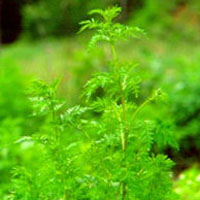Sweet Annie
Uses
Parts Used & Where Grown
This inconspicuous herb originated in Europe and Asia and has since spread to North America. It is now a common weed around the world. The above ground parts of the plant are used medicinally.
Our proprietary “Star-Rating” system was developed to help you easily understand the amount of scientific support behind each supplement in relation to a specific health condition. While there is no way to predict whether a vitamin, mineral, or herb will successfully treat or prevent associated health conditions, our unique ratings tell you how well these supplements are understood by the medical community, and whether studies have found them to be effective for other people.
For over a decade, our team has combed through thousands of research articles published in reputable journals. To help you make educated decisions, and to better understand controversial or confusing supplements, our medical experts have digested the science into these three easy-to-follow ratings. We hope this provides you with a helpful resource to make informed decisions towards your health and well-being.
3 StarsReliable and relatively consistent scientific data showing a substantial health benefit.
2 StarsContradictory, insufficient, or preliminary studies suggesting a health benefit or minimal health benefit.
1 StarFor an herb, supported by traditional use but minimal or no scientific evidence. For a supplement, little scientific support.
This supplement has been used in connection with the following health conditions:
| Used for | Why |
|---|---|
1 Star Diarrhea Refer to label instructions | Sweet annie has been used traditionally to treat infectious diarrhea and malaria. has been used traditionally to treat infectious diarrhea and malaria. However, more modern studies have used the isolated constituent artemisinin and it is unclear how effective the herb is in managing diarrhea. |
1 Star Parasites Refer to label instructions | Sweet Annie has been traditionally used for treatment of parasites. Numerous studies have suggested the herb can be helpful for some parasitic infections. Several other herbs are traditionally used for treatment of parasites, including male fern (Dryopteris filix mas) root, tansy (Tanacetum vulgare) leaf, wormwood, , black walnut (Juglans nigra) fruit, and cloves (Syzygium aromaticum). Numerous case reports and preliminary studies from the late 1800s and early 1900s have suggested some of these herbs can be helpful for some parasitic infections. |
Traditional Use (May Not Be Supported by Scientific Studies)
Ancient Chinese medical texts dating from around 150 B.C. suggest the use of sweet Annie for people with hemorrhoids.1 Other writings from 340 A.D. are the first known to mention sweet Annie as a treatment for people with fevers.2 It has been used ever since for a variety of infections in Traditional Chinese Medicine.
How It Works
Artemisinin, called qinghaosu in China where it was first discovered, is thought to account for the antimalarial activity of the plant.3, 4 This compound is a sesquiterpene lactone and is believed to cause damage to the organisms that cause malaria inside the red blood cells they infect. Preliminary and double-blind trials, have shown that injections or oral use of artemisinin or similar compounds rapidly and effectively cure people with malaria.5 A human trial has also found that artemisinin reduced mortality due to malaria by 50% compared with treatment with a standard quinoline anti-malarial drug.6 Artemisinin-based drugs have not been studied for prevention of malaria. Test tube studies suggest artemisinin can kill other parasites and bacteria,7 possibly supporting the traditional notion of using it for parasitic infections of the gastrointestinal tract.
How to Use It
Artemisinin-based drugs are not readily available in the United States or Europe and are still considered experimental. Sweet Annie cannot be substituted for artemisinin as a drug and cannot be used to treat people with malaria, a potentially lethal disease requiring immediate treatment. Traditionally, 3 grams of the powdered herb was taken each day.8
Interactions with Supplements, Foods, & Other Compounds
Interactions with Medicines
Side Effects
No serious adverse effects have been seen in clinical trials with artemisinin.9 The use of the whole herb as well as artemisinin may cause upset stomach, loose stools, abdominal pain, and occasional fever.
1. Foster S, Yue CX. Herbal Emissaries: Bringing Chinese Herbs to the West. Rochester, VT: Healing Arts Press, 1992, 322.
2. Foster S, Yue CX. Herbal Emissaries: Bringing Chinese Herbs to the West. Rochester, VT: Healing Arts Press, 1992, 322.
3. Hien TT, White NJ. Qinghaosu. Lancet 1993;341:603-8 [review].
4. Tang W, Eisenbrand G. Chinese Drugs of Plant Origin. Berlin: Springer-Verlag, 1992, 160-74.
5. Hien TT, White NJ. Qinghaosu. Lancet 1993;341:603-8 [review].
6. Hien TT, White NJ. Qinghaosu. Lancet 1993;341:603-8 [review].
7. Bone K, Morgan M. Clinical Applications of Ayurvedic and Chinese Herbs: Monographs for the Western Herbal Practitioner. Warwick, Australia: Phytotherapy Press, 1992, 7-12.
8. Foster S, Yue CX. Herbal Emissaries: Bringing Chinese Herbs to the West. Rochester, VT: Healing Arts Press, 1992, 322.
9. Hien TT, White NJ. Qinghaosu. Lancet 1993;341:603-8 [review].
Last Review: 05-12-2015

Copyright © 2024 TraceGains, Inc. All rights reserved.
Learn more about TraceGains, the company.
The information presented by TraceGains is for informational purposes only. It is based on scientific studies (human, animal, or in vitro), clinical experience, or traditional usage as cited in each article. The results reported may not necessarily occur in all individuals. For many of the conditions discussed, treatment with prescription or over the counter medication is also available. Consult your doctor, practitioner, and/or pharmacist for any health problem and before using any supplements or before making any changes in prescribed medications. Information expires December 2024.
This information does not replace the advice of a doctor. Ignite Healthwise, LLC, disclaims any warranty or liability for your use of this information. Your use of this information means that you agree to the Terms of Use. Learn how we develop our content.

